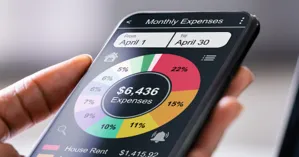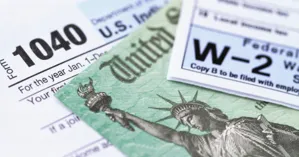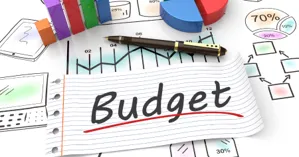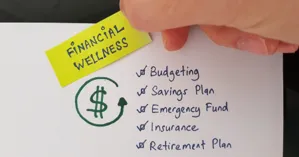- Quick Summary
- Understanding Your Financial Landscape
- Develop a Business Plan
- Open a Business Bank Account
- Choose an Accounting System
- Track all Business Expenses
- Track Your Income
- Save for Taxes and Retirement Savings
- Start an Emergency Fund
- Implement a Budget
- Manage Cash Flow and Invoicing
- Anticipate Dry Spells
- Plan for Financial Stability in the Future
- Conclusion

- Quick Summary
- Understanding Your Financial Landscape
- Develop a Business Plan
- Open a Business Bank Account
- Choose an Accounting System
- Track all Business Expenses
- Track Your Income
- Save for Taxes and Retirement Savings
- Start an Emergency Fund
- Implement a Budget
- Manage Cash Flow and Invoicing
- Anticipate Dry Spells
- Plan for Financial Stability in the Future
- Conclusion
Many freelancers dive into their trade without a thought to the financial end of it. But that is the wrong approach. You should think of your freelance work as a business. And a business has a financial plan. So, we’ve developed the ultimate guide to creating a financial plan for freelancers. A solid financial plan is crucial for maintaining overall financial health and stability throughout your career.
Understanding Your Financial Landscape

Assess Your Current Financial Situation
Before you can chart a course to financial stability, you need to know where you currently stand. Assessing your current financial situation involves taking a close look at your income, expenses, debts, and financial goals. This step is crucial for making informed decisions about both your business and personal finances.
Start by gathering all your financial documents, such as bank statements, invoices, and tax returns. Calculate your net income by subtracting your business expenses from your total freelance income. Next, list your fixed expenses—those recurring costs like rent, utilities, and insurance—and your variable expenses, which can fluctuate from month to month.
Once you have a clear picture of your income and expenses, identify areas where you can cut back on unnecessary spending. Redirect those savings towards your financial goals, whether that’s building an emergency fund, investing in retirement accounts, or saving for a major purchase.
Consider consulting a financial advisor to help you assess your financial situation and create a personalized financial plan. A professional can provide valuable insights and guidance, helping you identify areas for improvement and set realistic financial goals.
Determine Your Freelance Business Structure
Choosing the right business structure is a critical decision for any freelancer. The structure you select will affect your liability, taxes, and overall business operations. The most common options for freelancers include sole proprietorship, limited liability company (LLC), and partnership.
A sole proprietorship is the simplest and most straightforward structure, but it offers limited liability protection. This means that your personal assets could be at risk if your business faces legal issues. An LLC, on the other hand, provides more liability protection and can offer tax benefits, but it requires more paperwork and formalities. Partnerships are another option if you’re working with one or more individuals, but they also come with their own set of pros and cons.
To determine the best structure for your freelance business, consider consulting with a financial advisor or accountant. They can help you navigate the complexities of each option and ensure you’re making an informed decision that aligns with your business needs and goals.
Develop a Business Plan

A business plan is similar to a GPS; it goes beyond the plan and becomes a strategy for success. Think of it as a blueprint for your business. And yes, you’re freelancing, but it’s a business. There are many items that need to be in a business plan. Effective financial planning is crucial for freelancers to thrive in an unpredictable income environment.
Create a Business Summary and Purpose
This is an exercise in fine-tuning your freelance goals. It accompanies your story. For example, what is the reason you chose to freelance? You should write down what your passion for this job is.
Ensure this section reflects your aspirations and core values. It should set the tone for your business. Determine what your freelance business stands for.
This may seem obvious, but as you get busy you might go off track from what you originally started to do. This part of the financial plan will keep you grounded.
Know Your Target Market
Understand who you want to work for. If you’re interested in coding, you may not want to veer into IT work just to make some money. Likewise, writing short posts on Facebook may not be your forte if you're a blog writer. If you don't know who your core client is, and who you want to target, you'll have a scattered approach.
If you know your core client, you’ll come to understand their pain points. You then can develop a skill or idea that will satisfy them. This means they’ll hire you. All because you knew who they were.
Plan Your Services
What will you offer for all that money your target market is going to pay you? By deciding your services, we mean choosing your niche. If you're a photographer, narrow down what type of pictures you'll take. Are you a wedding, portrait, animal, etc. photographer?
If you’re a writer, what type of writing will you do?
Make a list of your services. Note how long it takes to complete each item on your list so you can price it.
Develop an Annual Income
Decide what your income goal is. Once you have that number, divide that by 12. This will calculate your monthly income. This way, you can track your income. If you fall short one month, you’ll need to make it up the next.
Set a healthy goal, but be realistic, or you’ll become frustrated. Write your goals down and make them available to look at. This will keep you motivated. Additionally, ensure you allocate funds effectively toward retirement savings as part of your financial planning.
Establish Pricing and Workload
Once you have your income goal, you must price your work to help you reach that goal. Be realistic when establishing your pricing. Keep in mind how much work you can actually do per week.
If you're a freelance writer and want to make $5,000 a month, how much do you need to price each blog, and how many can you realistically write per week?
For example, if you price each 1,200-word blog at $50, it would take you 25 per week to earn $5,000. Is this realistic? Consider raising your price, but be aware that you could price yourself out of the market.
It’s tricky. Doing research into what other freelancers charge can be helpful.
Besides a business plan, there are other items you’ll need to check off your list.
Open a Business Bank Account

Resist the urge to merge your business money with your personal money. It can quickly turn into a hot mess.
Remember, you must pay taxes, and if you merge the two accounts, it will be impossible to tell the difference between your business income and Aunt Nel’s birthday check. Keeping business and personal finances separate is crucial for accurately determining taxable income and ensuring compliance with tax obligations.
Pay yourself from your business account on a regular basis. Don’t just grab money here and there.
Choose an Accounting System

You might be a one-man show, but you’ll need to keep your finances organized. After all, you’ll be billing clients and tracking who has paid and who is delinquent.
Having an accounting system will help keep you on track. It will also help you when tax season comes around. An accurate accounting system is essential to report your freelance income correctly and ensure you pay income tax.
Use an accounting software like Quickbooks. It’s easy to use and will keep your finances organized.
Track all Business Expenses

Track your business expenses in your accounting system. Some expenses may be:
- office equipment
- Wi-Fi
- office space
- mileage
You know what you spend money on to keep your business going. Keep receipts, scan and load them into your accounting system. Having a well-defined investment strategy can also help manage these expenses and enhance your overall earning potential.
Track Your Income

Keep track of your income's ebb and flow. If your business is cyclical, plan for downtime.
Every dollar should be accounted for. Track how much you are bringing in versus how much your time is worth using your accounting software.
If you don’t have the accounting software, then use a spreadsheet.
Write down how much work you have booked monthly and the payment details. This is the only way to track what you’re owed.
Follow Up on Late Payments
Income can be inconsistent and often you'll have clients who pay late. Twenty-nine percent of freelancers claim late payments are a major challenge.
Send out reminders before the payment becomes too late. Some accounting software will assist you with this.
Ensure you make it clear that the payment is due within 30 days. Many clients may think they have longer.
Consider adding a late to motivate payment.
Save for Taxes and Retirement Savings

You’re not an employee anymore, so you need to pay your own taxes. Set yourself up to pay quarterly so you won’t get into a hole by the end of the year.
An alternative option is to open a tax bank account and store money in it to pay taxes. But this takes discipline not to touch if money gets tight.
Figure on saving 20 to 30 percent of your income. Remember, you’re not only paying taxes, but you must pay your FICA taxes as well. That’s your Social Security tax.
Consult with an accountant to determine what would work for you. Effective financial planning is crucial in managing your tax obligations and ensuring compliance.
Start an Emergency Fund

Put a little money away every week in a high-yield savings account, and don’t touch it. That will be your emergency fund.
If something happens and you can work, you’ll have this fund. It will also come in handy if you suddenly need a new computer because yours just crashed. Building an emergency fund is a crucial step towards ensuring your overall financial health and stability.
Implement a Budget

A sound financial plan has a budget. Everything we’ve talked about should be part of your budget. Some freelancers just play it by ear and don’t consider a budget. But burying your head in the sand is a terrible idea when it comes to finances. After all, this is your livelihood. Effective financial planning is crucial for creating and maintaining a budget.
Remember to pay attention to your expenses and income. Consider the 50/30/20 rule. That’s when you set up a budget so that your income is designated to specific areas. These include:
-
expenses – 50%
-
want spending (entertainment, dining, coffee shop) – 30%
-
savings (or credit card debt) – 20%
If you are in a deficit, then you’ll need to cut an expense. It should come out of the want spending. You don’t need to dine out three times a week.
When it comes to budgeting, there are several items you should be aware of and adjust.
Diversify Your Income Sources
Fifty-seven percent of freelancers have multiple clients. That way if you lose one, you’re not a financial wreck. Don’t put all your apples in one basket. If you only rely on one client, you’re trapped and unable to refuse requests or negotiate deals. Even if you’re unhappy, you can’t leave.
One client could suddenly have financial problems and be unable to pay you.
Always try to have several relatively equal income sources. Having a well-defined investment strategy that aligns with your risk tolerance and financial goals can help diversify income streams and mitigate risks.
Manage Cash Flow and Invoicing

Best Practices for Invoicing and Managing Cash Flow
Effective cash flow management is the lifeblood of any freelance business. Ensuring you get paid on time and maintaining a healthy financial situation requires a well-organized invoicing process and diligent tracking of your income and expenses. Here are some best practices to help you manage your cash flow and invoicing:
- Create a Clear Invoicing Process: Develop a standard invoicing process that includes a detailed description of the work completed, the amount due, and the payment terms. This clarity helps avoid misunderstandings and ensures your clients know exactly what they’re paying for.
- Use Online Invoicing Tools: Consider using online invoicing tools like FreshBooks or QuickBooks. These platforms can streamline your invoicing process, reduce errors, and help you keep track of payments and outstanding invoices.
- Set Clear Payment Terms: Establish clear payment terms with your clients from the outset. Specify the payment method, due date, and any late payment fees. Clear terms can help ensure timely payments and reduce the likelihood of late payments.
- Track Your Expenses: Keep meticulous records of your business expenses, including receipts, invoices, and bank statements. This not only helps you manage your cash flow but also makes tax time much easier.
- Manage Your Cash Flow: Regularly review your cash flow to ensure you have enough funds to cover your expenses and meet your financial goals. This involves monitoring your income streams, anticipating dry spells, and planning accordingly.
By following these best practices, you can ensure you’re managing your cash flow and invoicing effectively, maintaining a healthy financial situation, and setting yourself up for long-term financial security as a freelancer.
Anticipate Dry Spells

This is an unpredictable profession you’ve chosen. Sometimes you’ll have too much work, and sometimes nothing will come across your desk.
Learn the ebb and flow of your business. If you know that you’re usually not busy in January and February, ensure you save enough money to cover your bills during those downtimes. Effective financial planning is crucial for preparing for income fluctuations and ensuring financial stability.
You also could diversify and find a different type of work during those slow months.
Plan for Financial Stability in the Future

You don’t have a 401 (k) plan when you freelance. So, you’ll need to make your own. Take some of your money and invest. Remember, investing is a long-term endeavor. Don’t expect to get rich overnight. You’ll need to let your money grow.
Money devalues over time, so take advantage of investing sooner than later. Work with a financial advisor to form a plan to meet your goals. Additionally, planning for retirement savings and securing health insurance are crucial aspects of long-term financial planning.
Conclusion
A freelancer's financial plan takes some planning, but it's worth it. Watch your money, anticipate its ebb and flow, and plan accordingly.
Don’t go it alone. Gather some experts to help you. These should be an accountant to set you up and a financial advisor to help you invest.





